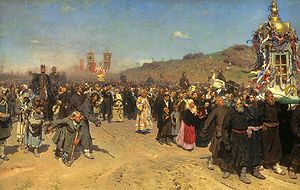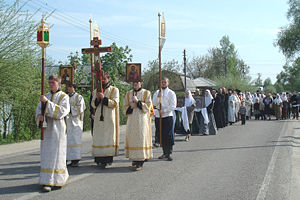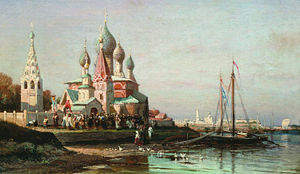- Crucession
-
 Crucession in Kursk Province, Bright Week procession with the icon of Our Lady of Kursk (in shrine, at right), as painted by Ilya Repin, 1880-83 (State Tretyakov Gallery, Moscow).
Crucession in Kursk Province, Bright Week procession with the icon of Our Lady of Kursk (in shrine, at right), as painted by Ilya Repin, 1880-83 (State Tretyakov Gallery, Moscow).
A Crucession, or Cross Procession (Russian: Крестный ход, Krestnyi khod), is a procession that takes place in the Eastern Orthodox and Eastern Catholic liturgical traditions. The name derives from the fact that the procession is headed by a cross.
Normally, the Crucession is preceded by a lantern. Then comes the cross, flanked by processional banners and icons. The Choir and Clergy will come next, followed by the faithful. If there are altar servers, the Crucession will be accompanied by incense and candles. During the Crucession, the choir sings hymns that are particular to the event the Crucession celebrates. Crucessions will often circle around the outside of the Temple (church building) three times, then come to stop on the front steps of the building, where the next portion of the service will take place. Other Crucessions will be in the form of a procession from the Temple to a particular location where the next portion of the service will take place.
Contents
Occasions
The most well-known Crucessions are:
- Holy Week—On Great Saturday, a Crucession is made as the clergy carry the Epitaphios (Slavonic: Plashchanitsa) around the Temple three times, as the Choir sings the Trisagion. After the third circuit of the Temple, the clergy cary the Epitaphios into the Temple, and hold it above the door, so that as all enter the Temple they pass under the Epitaphios, symbolically entering with Christ into the tomb. Because this is a sorrowful procession, the banners are not carried in this Crucession.[1]
- Pascha (Easter)—The first Paschal Crucession takes place during the Paschal Vigil on Easter Sunday; then there is another Crucession called for on every day of Bright Week either following Paschal Matins or after the Paschal Divine Liturgy. During the Crucession the Choir sings the Paschal Canon. On the weekdays of Bright Week the Artos is carried in the Crucession (though not at the Crucession during the Paschal Vigil, because at that point it has not yet been blessed).
- Theophany—Procession at the end of Liturgy from the Temple to a river or shore where the Great Blessing of Waters will take place. Afterwards, the Crucession returns to the Temple for the completion of the service. The choir sings special hymns of the Feast written for this service.[2]
- Dormition—In those churches and monasteries that observe the rite of the Burial of the Mother of God, a crucession takes place with the Epitaphios of the Theotokos, patterned after the one on Great Saturday.
- Moleben—Usually on the Patronal Feast of a Church or Monastery, there will be a Crucession around the outside of the Temple, while a Moleben (prayer of intercession) is celebrated to the Patron Saint.
- Funeral—The coffin is carried from the Temple to the grave in a crucession. If it is the funeral of a layman, the choir sings the Trisagion; if the deceased is a priest or bishop the clergy will chant the Great Canon of St. Andrew.
Notable crucessions
In 1991, the relics of St. Seraphim of Sarov were rediscovered after being hidden in a Soviet anti-religious museum for seventy years. This caused a sensation in post-Soviet Russia, and indeed throughout the Orthodox world. A crucession was formed to escort the relics, on foot, all the way from Moscow to St. Seraphim-Diveyevo Convent, where they remain to this day. The Patriarch of Moscow himself took part in a portion of this crucession.
During April 2, 2006 — July 18, 2006 an international Crucession was carried out across Transnistria, Ukraine, Belarus, and Russia.[3]
On May 20, 2007 probably the longest krestny khod was started in the city of Vladivostok on Russia's Pacific coast that will go all the way to Moscow. [4]
Notes
- ^ In some traditions, a Crucession takes place on Palm Sunday as well.
- ^ A similar procession will take place on August 1, the feast of the Procession of the Cross, at which the Lesser Blessing of Waters is used.
- ^ International Krestny Khod
- ^ All-Russia Krestny Khod
See also
External links
- Traditional Crucession
- Crucession on the Feast of the Dormition
- Crucession at Ascension Convent on the Mount of Olives at Jerusalem
Categories:- Eastern Orthodoxy
- Oriental Orthodoxy
- Eastern Catholicism
- Eastern Christian liturgy
- Christian festivals and holy days
- Easter
- Religious holidays
- Ceremonies
- Death customs
Wikimedia Foundation. 2010.




